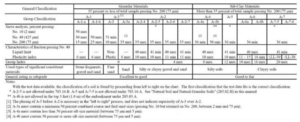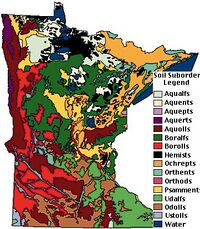
Difference between revisions of "Soil classification"
m () |
m () |
||
| Line 4: | Line 4: | ||
[[File:AASHTO classification image.png|300px|thumb|alt=AASHTO classification system|<font size=3>AASHTO soil classification system (From [https://wisconsindot.gov/Documents/doing-bus/eng-consultants/cnslt-rsrces/geotechmanual/gt-03-03.pdf Wisconsin Department of Transportation]. Click on image to enlarge.</font size>]] | [[File:AASHTO classification image.png|300px|thumb|alt=AASHTO classification system|<font size=3>AASHTO soil classification system (From [https://wisconsindot.gov/Documents/doing-bus/eng-consultants/cnslt-rsrces/geotechmanual/gt-03-03.pdf Wisconsin Department of Transportation]. Click on image to enlarge.</font size>]] | ||
| − | Soils are typically classified based on a specific property, such as infiltration or texture. This page provides a summary of the more commonly used classification systems. | + | Soils are typically classified based on a specific property, such as infiltration or <span title="Soil texture (such as loam, sandy loam or clay) refers to the proportion of sand, silt and clay sized particles that make up the mineral fraction of the soil."> '''texture'''</span>. This page provides a summary of the more commonly used classification systems. |
==USDA classification based on soil textures== | ==USDA classification based on soil textures== | ||
| − | The United States Department of Agriculture defines twelve major soil texture classifications (sand, loamy sand, sandy loam, loam, silt loam, silt, sandy clay loam, clay loam, silty clay loam, sandy clay, silty clay, and clay). Soil textures are classified by the fractions of sand, silt, and clay in a soil. Classifications are typically named for the primary constituent particle size or a combination of the most abundant particles sizes (e.g. sandy clay, silty clay). Loams are soils having roughly equal proportions of sand, silt, and/or clay in a soil sample. | + | The United States Department of Agriculture defines twelve major soil texture classifications (<span title="Particles with a diameter of between 0.074 and 4.75 millimeters."> '''sand'''</span>, loamy sand, sandy loam, <span title="A soil with roughly equal proportions of clay, silt, and sand"> '''loam'''</span>, <span title="Fine-grained soil particles with a diameter between 0.002 mm and 0.06 mm."> '''silt'''</span> loam, silt, sandy <span title="Fine-grained soil particles with a particle diameter less than 0.002 mm"> '''clay'''</span> loam, clay loam, silty clay loam, sandy clay, silty clay, and clay). Soil textures are classified by the fractions of sand, silt, and clay in a soil. Classifications are typically named for the primary constituent particle size or a combination of the most abundant particles sizes (e.g. sandy clay, silty clay). Loams are soils having roughly equal proportions of sand, silt, and/or clay in a soil sample. |
| − | Texture affects many soil properties, such as infiltration, structure, porosity, water holding capacity, and chemistry. For more information on the role and importance of soil texture, [https://www.senecahs.org/pages/uploaded_files/Soil%20Texture%20and%20Structure%20E%20Unit.pdf link here]. | + | Texture affects many soil properties, such as infiltration, <span title="Soil structure describes the arrangement of the solid parts of the soil and of the pore space located between them. It is determined by how individual soil granules clump, bind together, and aggregate, resulting in the arrangement of soil pores between them."> '''structure'''</span>, <span title="Porosity or void fraction is a measure of the void (i.e. empty) spaces in a material, and is a fraction of the volume of voids over the total volume, between 0 and 1, or as a percentage between 0% and 100%."> '''porosity'''</span>, <span title="The ability of a certain soil texture to physically hold water against the force of gravity"> '''water holding capacity'''</span>, and chemistry. For more information on the role and importance of soil texture, [https://www.senecahs.org/pages/uploaded_files/Soil%20Texture%20and%20Structure%20E%20Unit.pdf link here]. |
| − | The soil texture triangle is based on grain size, that is the distribution of sand, silt, and clay in a soil. The texture triangle is shown in the adjacent image. The relationship to soil hydrologic group, which is used in stormwater applications, is illustrated in this image. | + | The soil texture triangle is based on grain size, that is the distribution of sand, silt, and clay in a soil. The texture triangle is shown in the adjacent image. The relationship to <span title="A soil classification system (Natural Resource Conservation System) based on runoff potential. Groups include A soils (coarse textured with very low runoff potential), B soils (medium coarse textured with low runoff potential), C soils (fine to moderate textured with moderate runoff potential), and D soils (fine textured with high runoff potential)."> '''[https://stormwater.pca.state.mn.us/index.php?title=Design_infiltration_rates hydrologic soil group]'''</span>, which is used in stormwater applications, is illustrated in this image. |
==Natural Resource Conservation Service Hydrologic Soil Groups== | ==Natural Resource Conservation Service Hydrologic Soil Groups== | ||
Revision as of 16:07, 16 June 2021
Contents
- 1
- 1.1 USDA classification based on soil textures
- 1.2 Natural Resource Conservation Service Hydrologic Soil Groups
- 1.3 Unified Soil Classification System (USCS)
- 1.4 American Association of State Highway and Transportation Officials (AASHTO) Soil Classification System
- 1.5 USDA Soil Taxonomy
- 1.6 Other classification systems
- 1.7 Related links
![image of soil texture triangle]](/images/thumb/7/79/Soil_texture_triangle.jpg/300px-Soil_texture_triangle.jpg)


Soils are typically classified based on a specific property, such as infiltration or texture. This page provides a summary of the more commonly used classification systems.
USDA classification based on soil textures
The United States Department of Agriculture defines twelve major soil texture classifications ( sand, loamy sand, sandy loam, loam, silt loam, silt, sandy clay loam, clay loam, silty clay loam, sandy clay, silty clay, and clay). Soil textures are classified by the fractions of sand, silt, and clay in a soil. Classifications are typically named for the primary constituent particle size or a combination of the most abundant particles sizes (e.g. sandy clay, silty clay). Loams are soils having roughly equal proportions of sand, silt, and/or clay in a soil sample.
Texture affects many soil properties, such as infiltration, structure, porosity, water holding capacity, and chemistry. For more information on the role and importance of soil texture, link here.
The soil texture triangle is based on grain size, that is the distribution of sand, silt, and clay in a soil. The texture triangle is shown in the adjacent image. The relationship to hydrologic soil group, which is used in stormwater applications, is illustrated in this image.
Natural Resource Conservation Service Hydrologic Soil Groups
Reference: Urban Hydrology for Small Watersheds - TR-55 (USDA)
Soils are classified by the Natural Resource Conservation Service into four Hydrologic Soil Groups (HSG) based on the soil's runoff potential. The four Hydrologic Soils Groups are A, B, C and D. Where A's generally have the smallest runoff potential and Ds the greatest.
- Group A: sand, loamy sand or sandy loam types of soils. It has low runoff potential and high infiltration rates even when thoroughly wetted. They consist chiefly of deep, well to excessively drained sands or gravels and have a high rate of water transmission.
- Group B: silt loam or loam. It has a moderate infiltration rate when thoroughly wetted and consists chiefly or moderately deep to deep, moderately well to well drained soils with moderately fine to moderately coarse textures.
- Group C: sandy clay loam. They have low infiltration rates when thoroughly wetted and consist chiefly of soils with a layer that impedes downward movement of water and soils with moderately fine to fine structure.
- Group D: clay loam, silty clay loam, sandy clay, silty clay or clay. This HSG has the highest runoff potential. They have very low infiltration rates when thoroughly wetted and consist chiefly of clay soils with a high swelling potential, soils with a permanent high water table, soils with a claypan or clay layer at or near the surface and shallow soils over nearly impervious material.
This classification system is the most widely used system in the Minnesota Stormwater Manual and in most stormwater applications in the U.S. BMP selection and design are typically based on soils at a site. For example, infiltration bmps are preferred on HSG A and B soils when there are no other site restrictions (e.g. contamination, presence of active karst).
Link to infiltration rates based on hydrologic soil group
Unified Soil Classification System (USCS)
The Unified Soil Classification System (USCS) is used in engineering and geology to describe the texture and grain size of a soil. Unconsolidated materials are represented by a two-letter symbol based on type of material (gravel (G), sand (S), silt (M), clay (C), organic (O)) and grading or plasticity (well-graded (W), poorly-graded (P), high plasticity (H), low plasticity (L)). For example, CH materials consist of clay with high plasticity, and SP materials consist of poorly-graded sands. Specific properties of these soils can be found here. This classification is used for engineering applications, where factors such as soil strength and uniformity are important for structural applications.
The adjacent image shows the relationship between the USCS, AASHTO and USDA classifications.
American Association of State Highway and Transportation Officials (AASHTO) Soil Classification System
The AASHTO Soil Classification System was developed by the American Association of State Highway and Transportation Officials, and is used as a guide for the classification of soils and soil-aggregate mixtures for highway construction purposes.
USDA Soil Taxonomy

USDA soil taxonomy provides a classification of soil types according to several parameters (most commonly their properties) and in several levels: Order, Suborder, Great Group, Subgroup, Family, and Series. There are currently twelve soil orders. Suborders are based on a specific property, such as temperature or moisture (e.g. aquic for wet) regime.
For more information, link here.
Other classification systems
- Australia classification system
- Canadian classification system
- Food and Agricultural Organization of the United Nations
Related links
- Soil Classification Systems - Wisconsin Department of Transportation
- World Reference Base for Soil Resources